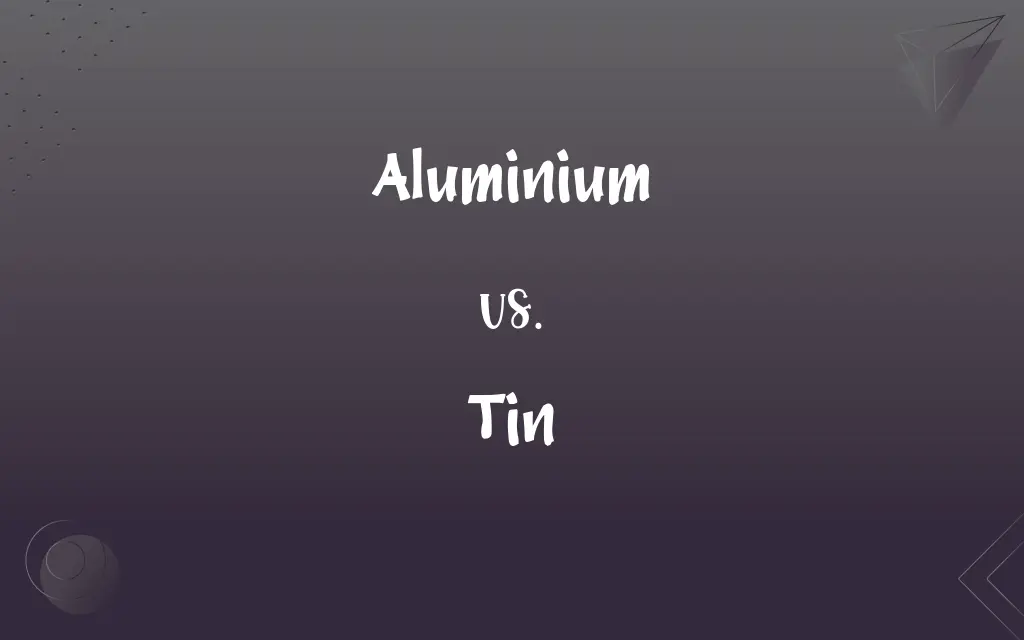Aluminium vs. Tin: What's the Difference?
Edited by Janet White || By Harlon Moss || Published on December 3, 2023
Aluminium is a lightweight, silver-white metal, highly conductive and resistant to corrosion; tin is a softer, malleable metal, often used to coat other metals for protection.

Key Differences
Aluminium is a lightweight, silvery-white metal, known for its strength and resistance to corrosion. Tin, in contrast, is softer and more malleable, and it has a lower melting point than aluminium. Both metals are used extensively in various industries due to their distinct properties.
The conductivity of aluminium is high, making it ideal for electrical applications. Tin, while also conductive, is less efficient than aluminium in this regard. However, tin's resistance to corrosion makes it valuable for coating other metals, such as steel, to prevent rust.
Aluminium is abundant in the earth's crust and is commonly extracted from bauxite ore. Tin is less abundant and is extracted from ores like cassiterite. The extraction and processing methods for both metals are distinct, reflecting their different chemical properties.
In terms of usage, aluminium is widely used in construction, aerospace, and packaging industries due to its lightweight and strength. Tin is often used in solder, tin plating, and in alloys such as bronze. Both metals are recyclable, contributing to sustainable practices in metal usage.
The history of aluminium and tin usage dates back centuries, with tin being used in ancient times for bronze making. Aluminium's use surged in the 19th century with advancements in extraction techniques. Both metals have played significant roles in human technological development.
ADVERTISEMENT
Comparison Chart
Physical Properties
Lightweight, strong, silver-white
Softer, malleable, silvery-grey
Electrical Conductivity
High conductivity
Less conductive than aluminium
Extraction Source
Extracted from bauxite ore
Extracted from ores like cassiterite
Primary Uses
Construction, aerospace, packaging
Solder, tin plating, alloys
Historical Usage
Widely used since 19th century
Used since ancient times for bronze
ADVERTISEMENT
Aluminium and Tin Definitions
Aluminium
A material used for its corrosion-resistant properties.
Aluminium coatings are essential for marine applications.
Tin
A soft, malleable metal commonly used in alloys and coatings.
The tin coating protected the steel from rusting.
Aluminium
A metal used in alloy form to enhance strength and durability.
The car's engine contained an aluminium alloy for better performance.
Tin
A metal used for soldering electronic components.
He used tin solder to repair the circuit board.
Aluminium
A chemical element with symbol Al and atomic number 13.
Aluminium's atomic structure makes it ideal for conductive wiring.
Tin
A historic metal used in the creation of bronze.
Ancient civilizations valued tin for making bronze tools.
Aluminium
A lightweight, silvery metal used in manufacturing and construction.
The aircraft's body was made of high-strength aluminium.
Tin
A material used in tin plating for food cans and containers.
Food cans are often lined with tin to prevent corrosion.
Aluminium
A recyclable metal used in sustainable packaging solutions.
Beverage cans are often made from recycled aluminium.
Tin
A chemical element with the symbol Sn and atomic number 50.
Tin's properties are studied extensively in chemistry classes.
Aluminium
Variant of aluminum.
Tin
Symbol Sn A crystalline, silvery metallic element obtained chiefly from cassiterite, and having two notable allotropic forms. Malleable white tin is the useful allotrope, but at temperatures below 13.2°C it slowly converts to the brittle gray allotrope. Tin is used to coat other metals to prevent corrosion and is a part of numerous alloys, such as soft solder, pewter, type metal, and bronze. Atomic number 50; atomic weight 118.71; melting point 231.93°C; boiling point 2,602°C; specific gravity (gray) 5.77, (white) 7.29; valence 2, 4. See Periodic Table.
Aluminium
A light, silvery metal extracted from bauxite, and a chemical element (symbol Al) with an atomic number of 13.
Tin
Tin plate.
Aluminium
(countable) A single atom of this element.
Aluminium
(slang) Aircraft or other machinery made partially or wholly of aluminium.
Aluminium
Same as aluminum, chiefly British in usage.
Aluminium
A silvery ductile metallic element found primarily in bauxite
FAQs
How is tin extracted?
Tin is extracted from ores like cassiterite.
What are common uses of tin?
Tin is commonly used in tin plating, solder, and making bronze.
Is aluminium a good conductor of electricity?
Yes, aluminium is an excellent conductor of electricity.
What industries heavily use aluminium?
Aluminium is heavily used in aerospace, construction, and packaging industries.
What is the atomic number of aluminium?
Aluminium has the atomic number 13.
Is aluminium resistant to rust?
Aluminium is highly resistant to rust and corrosion.
What are the environmental impacts of aluminium production?
Aluminium production can have significant environmental impacts, including energy consumption and mining effects.
Can tin be used in food packaging?
Yes, tin is used in food packaging, especially for can linings.
How is tin solder used in electronics?
Tin solder is used to join electronic components together.
What is the symbol for tin in the periodic table?
The symbol for tin is Sn.
Can tin resist corrosion?
Yes, tin is corrosion-resistant, making it ideal for coatings.
What is the melting point of aluminium?
Aluminium has a melting point of about 660.3°C (1220.5°F).
What is the weight of aluminium compared to other metals?
Aluminium is lightweight compared to many other metals.
Is tin recyclable?
Yes, tin is recyclable.
What are the benefits of tin plating?
Tin plating provides corrosion resistance and enhances solderability.
Is aluminium found in the human body?
Aluminium is not naturally found in the human body.
Was tin historically important?
Yes, tin was historically important, especially in the creation of bronze in ancient times.
Are aluminium cans recyclable?
Yes, aluminium cans are highly recyclable.
Are there health concerns associated with aluminium?
Excessive exposure to aluminium can pose health risks, but normal exposure is generally considered safe.
How does the density of tin compare to other metals?
Tin has a lower density compared to many other metals.
About Author
Written by
Harlon MossHarlon is a seasoned quality moderator and accomplished content writer for Difference Wiki. An alumnus of the prestigious University of California, he earned his degree in Computer Science. Leveraging his academic background, Harlon brings a meticulous and informed perspective to his work, ensuring content accuracy and excellence.
Edited by
Janet WhiteJanet White has been an esteemed writer and blogger for Difference Wiki. Holding a Master's degree in Science and Medical Journalism from the prestigious Boston University, she has consistently demonstrated her expertise and passion for her field. When she's not immersed in her work, Janet relishes her time exercising, delving into a good book, and cherishing moments with friends and family.







































































